Contact Analysis and Friction Prediction of Non-Gaussian Random Surfaces
Abstract
:1. Introduction
2. Methodology
2.1. Methodology for Non-Gaussian Rough Surface Generation
- The unbound system ;
- The logarithm normal system where ;
- The bounded system where .
- Determine the transform coefficients through solving the nonlinear equations described by Equation (4);
- Modify the input kurtosis and skewness using Equations (9) and (10);
- Generate the random sequence, and then substitute the sequence and the modified skewness and kurtosis into the Johnson translation system for obtaining the prescribed non-Gaussian sequence;
- Generate the non-Gaussian surface with specified height distribution and ACF through linear transformation between the transform coefficients and the non-Gaussian sequence.
2.2. Friction Model
2.3. A Deterministic Contact Model of Rough Surfaces
3. Validation of the Current Method
4. Results and Discussion
4.1. Effect of Roughness Amplitude and Skewness
4.2. Effect of Kurtosis
4.3. Effects of Applied Load
5. Conclusions
- 1.
- Rough surfaces with positive skewness, because of more sharp peaks and less valleys, present larger contact pressure as well as a smaller contact area than the negatively skewed surfaces. With the increasing of roughness amplitude, the contact pressure increases, while the contact area decreases, both for the surface with positive skewness and negative skewness. In addition, the trends of friction coefficients with increasing roughness amplitude are similar for negatively skewed surfaces and positively skewed surfaces.
- 2.
- As the kurtosis increases, the contact area decreases while the contact pressure increases. Nevertheless, when the kurtosis becomes comparatively large, the variations of contact area and pressure become slight. The influence of kurtosis on friction coefficient is very slight, especially for .
- 3.
- The contact area increases as applied load increases. However, contact pressure first presents a clear increasing trend and then gradually declines because of more asperities coming into contact. Similar to the trend of contact pressure, friction coefficient first increases due to the increase in contact area and pressure, finally becoming constant.
Author Contributions
Funding
Institutional Review Board Statement
Informed Consent Statement
Data Availability Statement
Conflicts of Interest
References
- Feng, K.; Ji, J.C.; Li, Y.; Ni, Q.; Wu, H.; Zheng, J. A novel cyclic-correntropy based indicator for gear wear monitoring. Tribol. Int. 2022, 171, 107528. [Google Scholar] [CrossRef]
- Feng, K.; Ji, J.; Ni, Q. A novel adaptive bandwidth selection method for Vold–Kalman filtering and its application in wind turbine planetary gearbox diagnostics. Struct. Health Monit. 2022, 2022, 14759217221099966. [Google Scholar] [CrossRef]
- Zhao, T.Y.; Jiang, L.P.; Pan, H.G.; Yang, J.; Kitipornchai, S. Coupled free vibration of a functionally graded pre-twisted blade-shaft system reinforced with graphene nanoplatelets. Compos. Struct. 2021, 262, 113362. [Google Scholar] [CrossRef]
- Zhao, T.Y.; Cui, Y.S.; Pan, H.G.; Yuan, H.Q.; Yang, J. Free vibration analysis of a functionally graded graphene nanoplatelet reinforced disk-shaft assembly with whirl motion. Int. J. Mech. Sci. 2021, 197, 106335. [Google Scholar] [CrossRef]
- Zhao, T.Y.; Yan, K.; Li, H.W.; Wang, X. Study on theoretical modeling and vibration performance of an assembled cylindrical shell-plate structure with whirl motion. Appl. Math. Model. 2022, 110, 618–632. [Google Scholar] [CrossRef]
- Zhao, T.; Li, K.; Ma, H. Study on dynamic characteristics of a rotating cylindrical shell with uncertain parameters. Anal. Math. Phys. 2022, 12, 97. [Google Scholar] [CrossRef]
- Zhao, T.Y.; Ma, Y.; Zhang, H.Y.; Pan, H.G.; Cai, Y. Free vibration analysis of a rotating graphene nanoplatelet reinforced pre-twist blade-disk assembly with a setting angle. Appl. Math. Model. 2021, 93, 578–596. [Google Scholar] [CrossRef]
- Zhao, T.Y.; Wang, Y.X.; Pan, H.G.; Yuan, H.Q.; Yi, C. Nonlinear forced vibration analysis of spinning shaft-disk assemblies under sliding bearing supports. Math Models Methods Appl. Sci. 2021, 44, 12283–12301. [Google Scholar] [CrossRef]
- Feng, K.; Ji, J.C.; Ni, Q.; Beer, M. A review of vibration-based gear wear monitoring and prediction techniques. Mech. Syst. Signal Process. 2023, 182, 109605. [Google Scholar] [CrossRef]
- Bakolas, V. Numerical generation of arbitrarily oriented non-Gaussian three-dimensional rough surfaces. Wear 2003, 254, 546–554. [Google Scholar] [CrossRef]
- Reizer, R. Simulation of 3D Gaussian surface topography. Wear 2011, 271, 539–543. [Google Scholar] [CrossRef]
- Liao, D.; Shao, W.; Tang, J.; Li, J. An improved rough surface modeling method based on linear transformation technique. Tribol. Int. 2018, 119, 786–794. [Google Scholar] [CrossRef]
- Whitehouse, D.J. Handbook of Surface Metrology; Institute of Physics: Bristol, UK, 1994. [Google Scholar]
- Manesh, K.K.; Ramamoorthy, B.; Singaperumal, M. Numerical generation of anisotropic 3D non-Gaussian engineering surfaces with specified 3D surface roughness parameters. Wear 2010, 268, 1371–1379. [Google Scholar] [CrossRef]
- Patir, N. A numerical procedure for random generation of rough surfaces. Wear 1978, 47, 263–277. [Google Scholar] [CrossRef]
- Hu, Y.Z.; Tonder, K. Simulation of 3-D random rough surface by 2-D digital filter and fourier analysis. Int. J. Mach. Tools Manuf. 1992, 32, 83–90. [Google Scholar] [CrossRef]
- Wu, J.J. Simulation of rough surfaces with FFT. Tribol. Int. 2000, 33, 47–58. [Google Scholar] [CrossRef]
- Wu, J.-J. Simulation of non-Gaussian surfaces with FFT. Tribol. Int. 2004, 37, 339–346. [Google Scholar] [CrossRef]
- Francisco, A.; Brunetière, N. A hybrid method for fast and efficient rough surface generation. Proc. Inst. Mech. Eng. Part J. J. Eng. Tribol. 2016, 230, 747–768. [Google Scholar] [CrossRef]
- Watson, M.; Lewis, R.; Slatter, T. Improvements to the linear transform technique for generating randomly rough surfaces with symmetrical autocorrelation functions. Tribol. Int. 2020, 151, 106487. [Google Scholar] [CrossRef]
- Greenwood, J.A.; Williamson, J.B.P. Contact of nominally flat surfaces. Proc. R. Soc. Lond. Ser. A 1966, 295, 300–319. [Google Scholar]
- Zhao, Y.; Maietta, D.M.; Chang, L. An asperity microcontact model incorporating the transition from elastic deformation to fully plastic flow. ASME J. Tribol. 2000, 122, 86–93. [Google Scholar] [CrossRef]
- Greenwood, J.A. A simplified elliptical model of rough surface contact. Wear 2006, 261, 191–200. [Google Scholar] [CrossRef]
- Ciavarella, M.; Greenwood, J.A.; Paggi, M. Inclusion of “interaction” in the Greenwood and Williamson contact theory. Wear 2008, 265, 729–734. [Google Scholar] [CrossRef]
- Paggi, M.; Ciavarella, M. The coefficient of proportionality k between real contact area and load, with new asperity models. Wear 2010, 268, 1020–1029. [Google Scholar] [CrossRef]
- Greenwood, J.A.; Putignano, C.; Ciavarella, M.A. Greenwood & Williamson theory for line contact. Wear 2011, 270, 332–334. [Google Scholar]
- Liu, S.B.; Wang, Q.; Liu, G. A versatile method of discrete convolution and FFT (DC-FFT) for contact analyses. Wear 2000, 243, 101–111. [Google Scholar] [CrossRef]
- Polonsky, I.A.; Keer, L.M. A numerical method for solving rough contact problems based on the multi-level multi-summation and conjugate gradient techniques. Wear 1999, 231, 206–219. [Google Scholar] [CrossRef]
- Kim, T.W.; Bhushan, B.; Cho, Y.J. The contact behavior of elastic/plastic nonGaussian rough surfaces. Tribol. Lett. 2006, 22, 1–13. [Google Scholar] [CrossRef]
- Chen, W.W.; Wang, Q.J.; Liu, Y.; Chen, W.; Cao, J.; Xia, C.; Lederich, R. Analysis and convenient formulas for elastoplastic contacts of nominally flat surfaces: Average gap, contact area ratio, and plastically deformed volume. Tribol. Lett. 2007, 28, 27–38. [Google Scholar] [CrossRef]
- Wang, Z.J.; Wang, W.Z.; Hu, Y.Z.; Wang, H. A numerical elastic–plastic contact model for rough surfaces. Tribol. Trans. 2010, 53, 224–238. [Google Scholar] [CrossRef]
- Zhang, S.; Wang, W.; Zhao, Z. The effect of surface roughness characteristics on the elastic–plastic contact performance. Tribol. Int. 2014, 79, 59–73. [Google Scholar] [CrossRef]
- Michalski, J.; Pawlus, P. Description of honed cylinders surface topography. Int. J. Mach. Tools Manuf. 1994, 34, 199–210. [Google Scholar] [CrossRef]
- Tayebi, N.; Polycarpou, A.A. Modeling the effect of skewness and kurtosis on the static friction coefficient of rough surfaces. Tribol. Int. 2004, 37, 491–505. [Google Scholar] [CrossRef]
- Kogut, L.; Etsion, I. A Static Friction Model for Elastic-Plastic Contacting Rough Surfaces. J. Tribol. 2004, 126, 34–40. [Google Scholar] [CrossRef] [Green Version]
- Chang, L.; Jeng, Y.-R. Effects of negative skewness of surface roughness on the contact and lubrication of nominally flat metallic surfaces. Proc. Inst. Mech. Eng. Part J J. Eng. Tribol. 2013, 227, 559–569. [Google Scholar] [CrossRef]
- Sista, B.; Vemaganti, K. A Computational Study of Dry Static Friction Between Elastoplastic Surfaces Using a Statistically Homogenized Microasperity Model. J. Tribol. 2015, 137, 021601. [Google Scholar] [CrossRef]
- Zhang, X. Numerical investigation of sliding friction behaviour and mechanism of engineering surfaces. ILT 2019, 71, 205–211. [Google Scholar] [CrossRef]
- Sedlaček, M.; Podgornik, B.; Vižintin, J. Influence of surface preparation on roughness parameters, friction and wear. Wear 2009, 266, 482–487. [Google Scholar] [CrossRef]
- Sedlaček, M.; Podgornik, B.; Vižintin, J. Correlation between standard roughness parameters skewness and kurtosis and tribological behaviour of contact surfaces. Tribol. Int. 2012, 48, 102–112. [Google Scholar] [CrossRef]
- Mishra, T.; de Rooij, M.; Shisode, M.; Hazrati, J.; Schipper, D.J. Characterization of interfacial shear strength and its effect on ploughing behaviour in single-asperity sliding. Wear 2019, 436–437, 203042. [Google Scholar] [CrossRef]
- Kragelsky, I.V.; Dobychin, M.N.; Kombalov, V.S. Friction and Wear Calculation Methods; Pergamon Press: Oxford, UK, 1982. [Google Scholar]
- Liu, X.; Chetwynd, G.; Gardner, J.W. Surface characterization of electro-active thin polymeric film bearings. Int. J. Mach. Tools Manuf. 1998, 38, 669–675. [Google Scholar] [CrossRef]

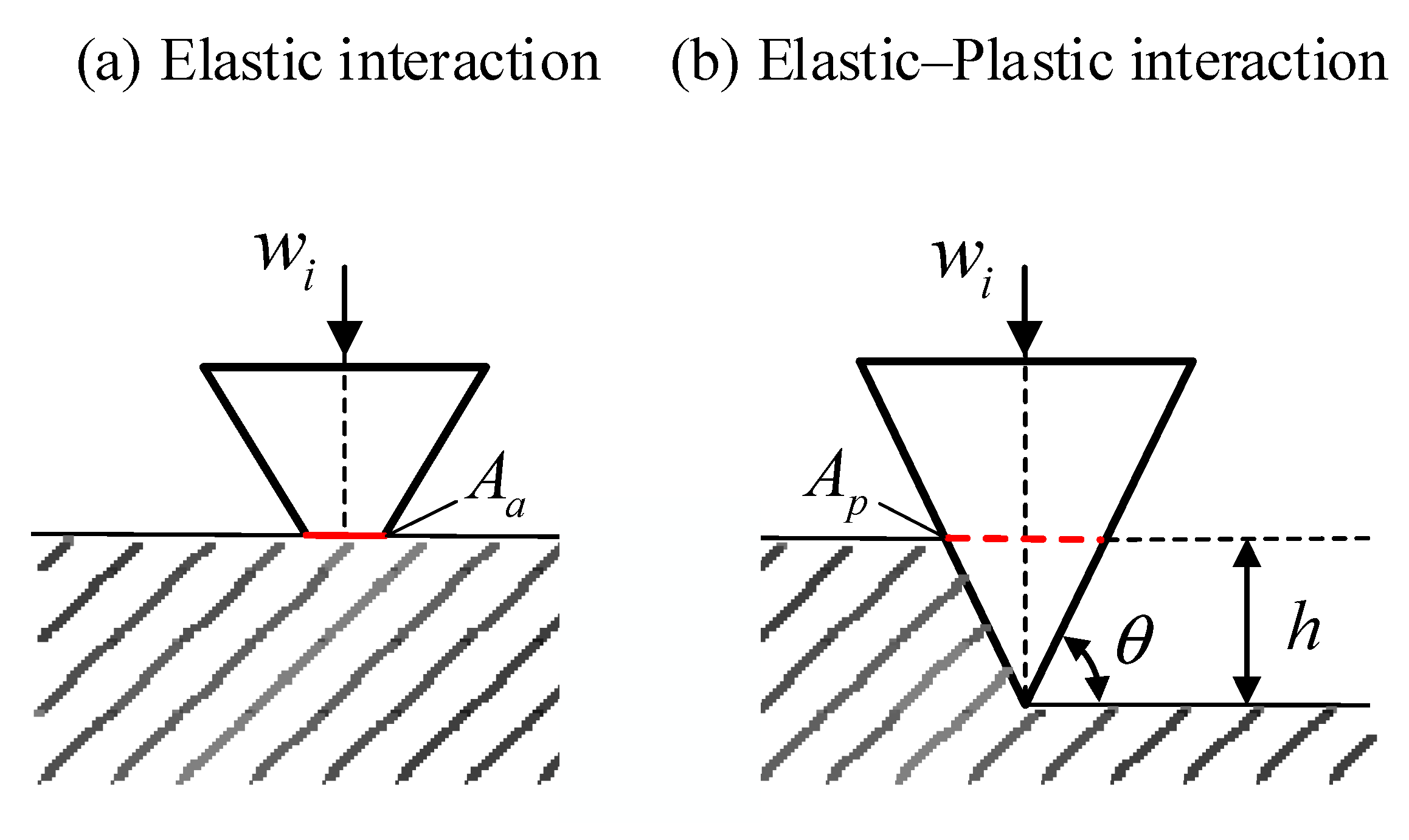
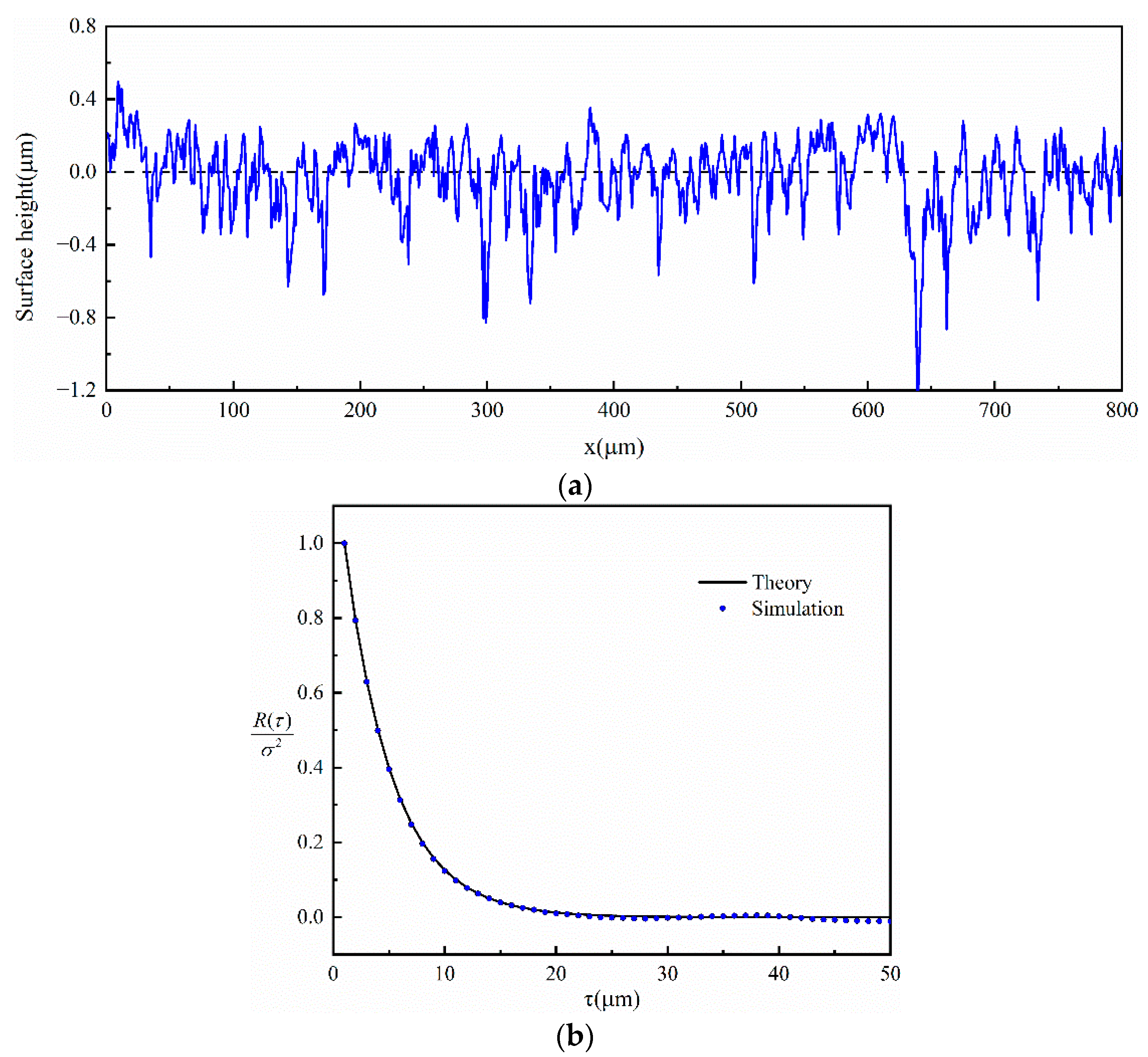
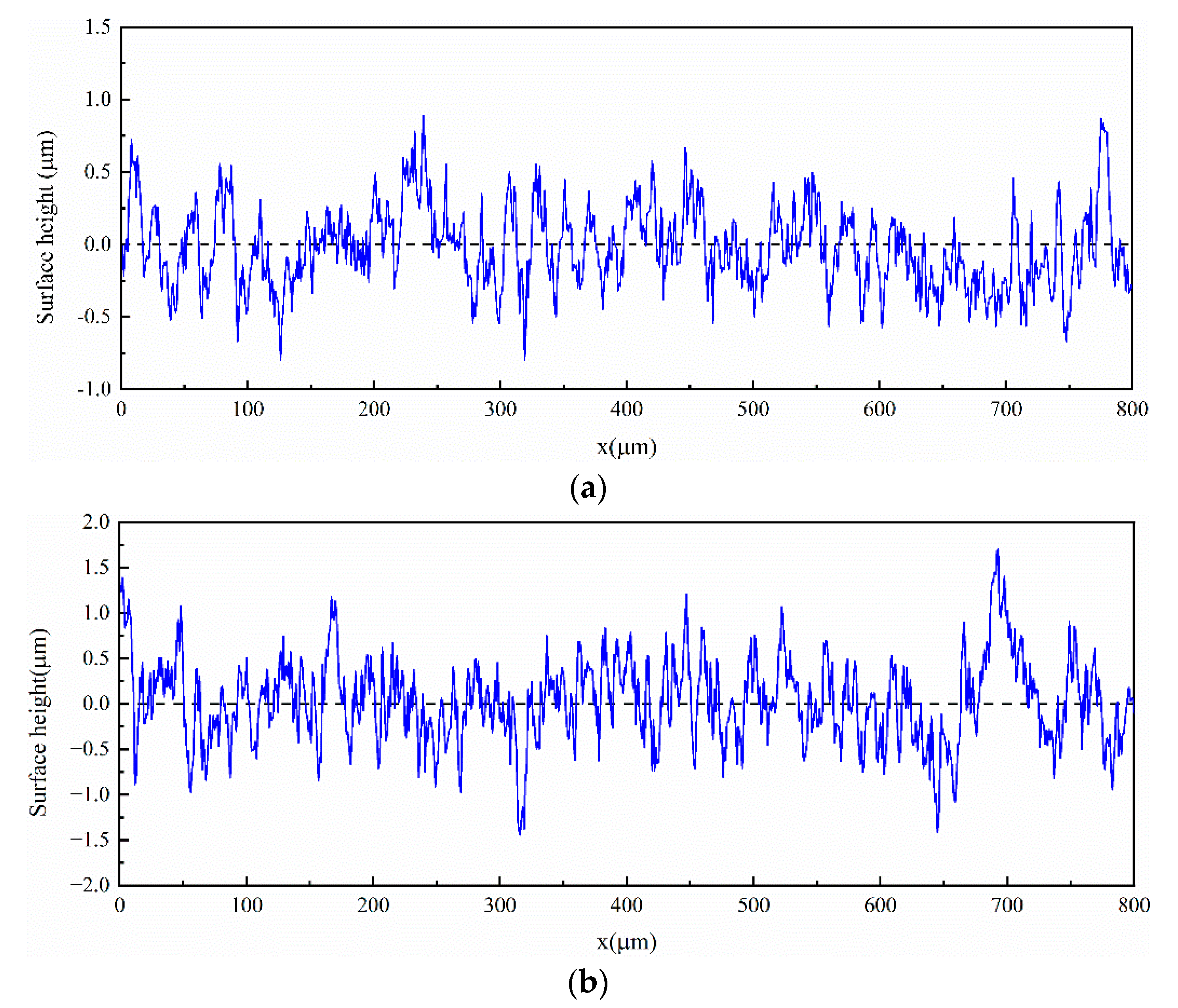
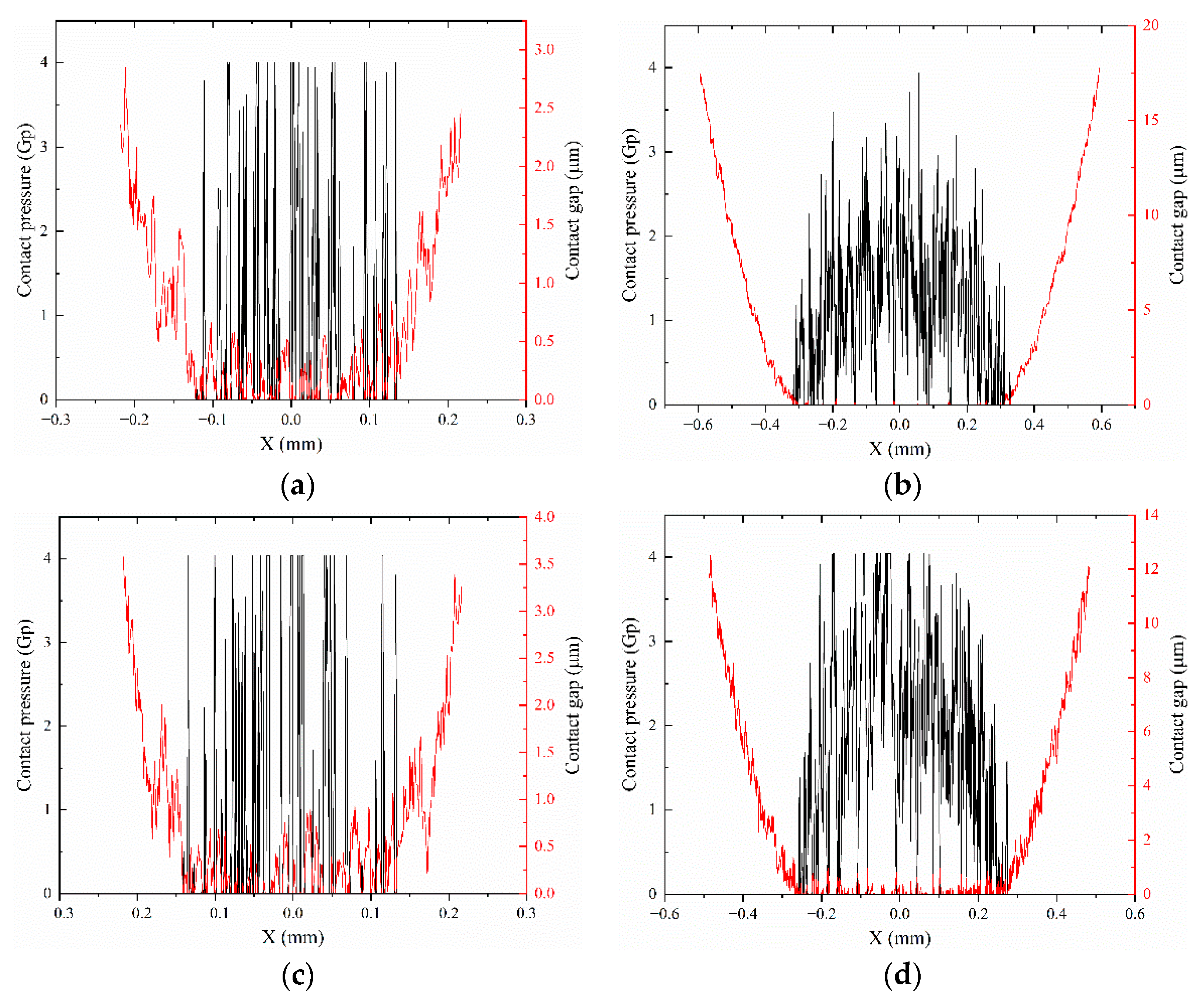
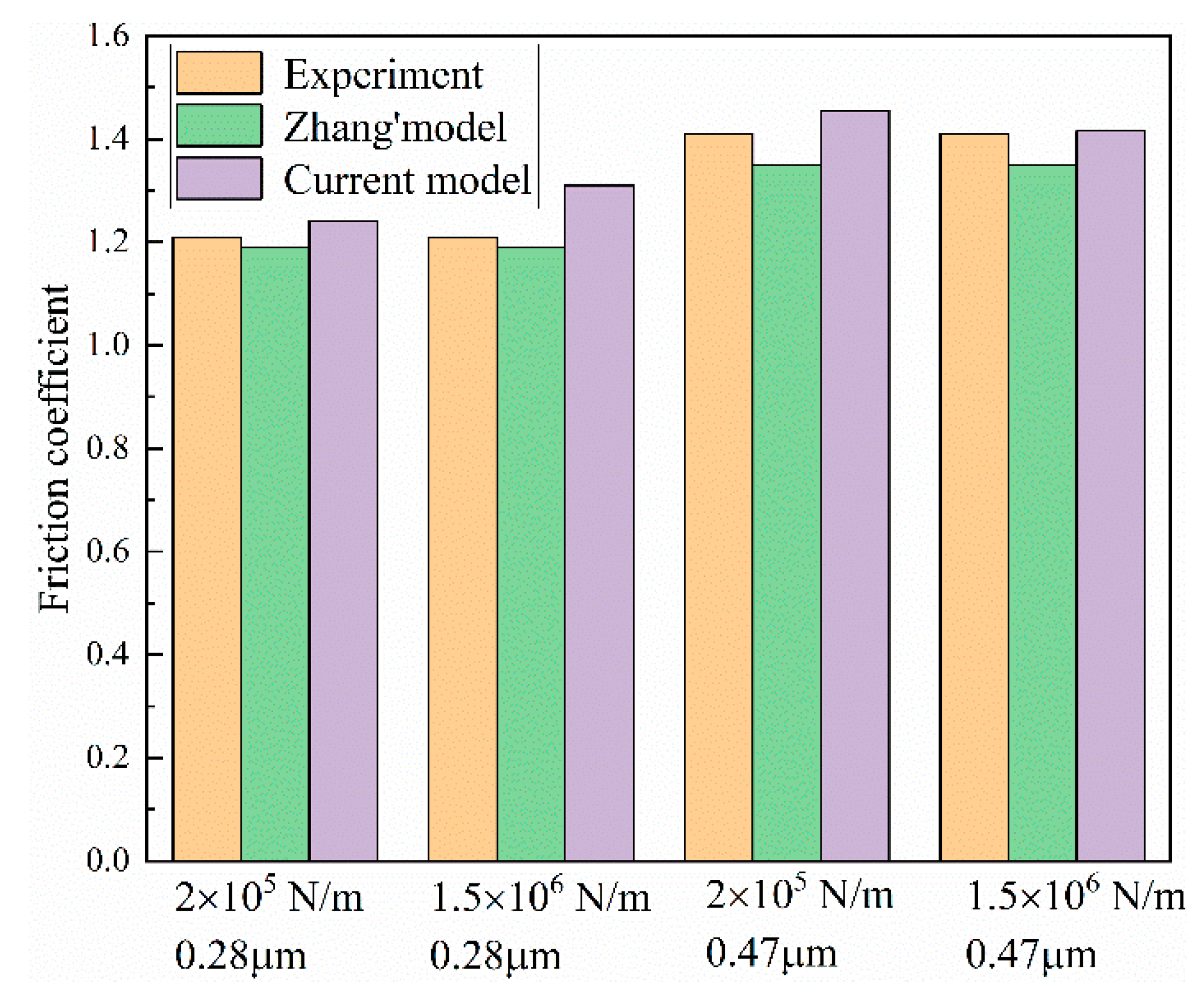
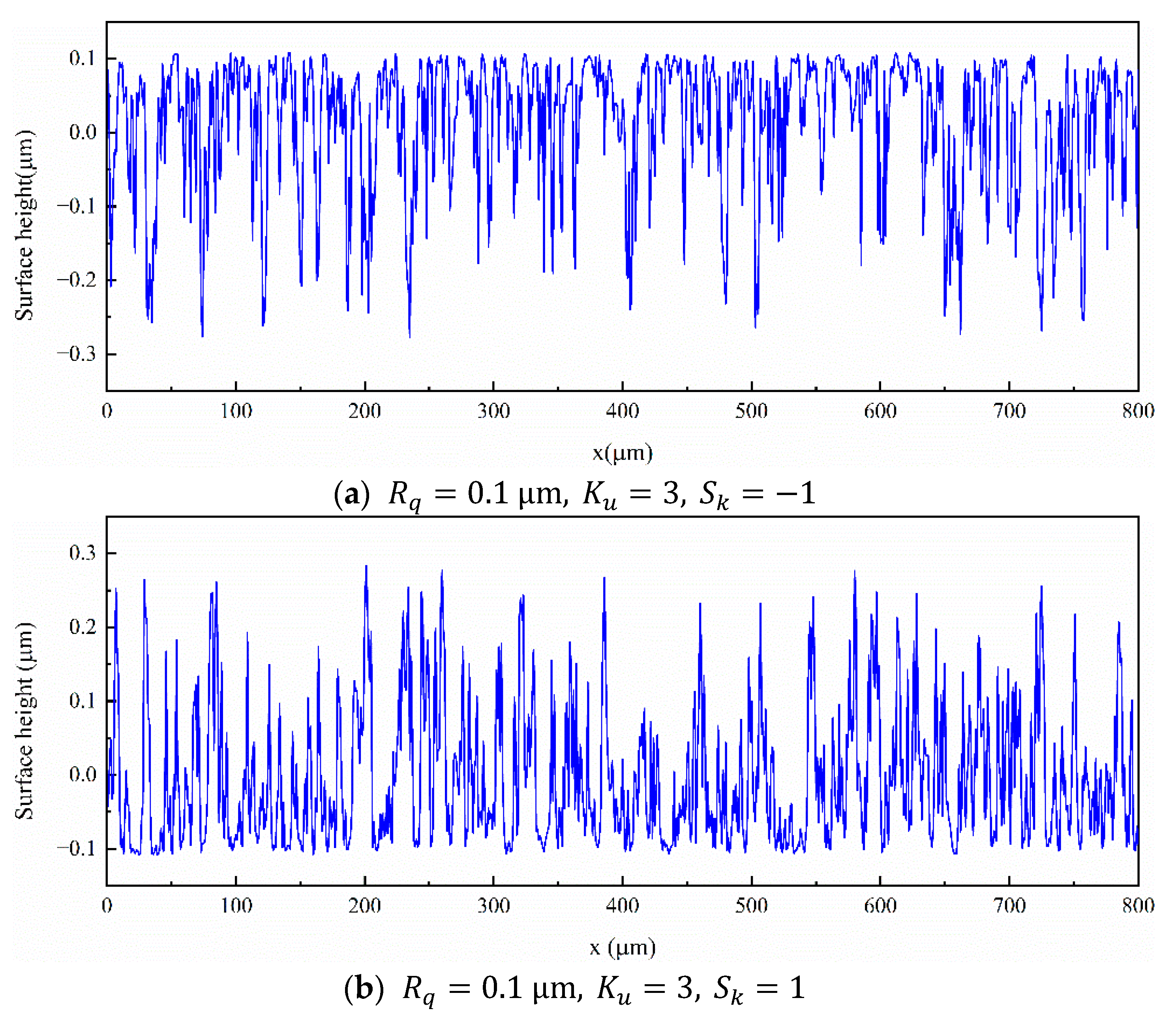

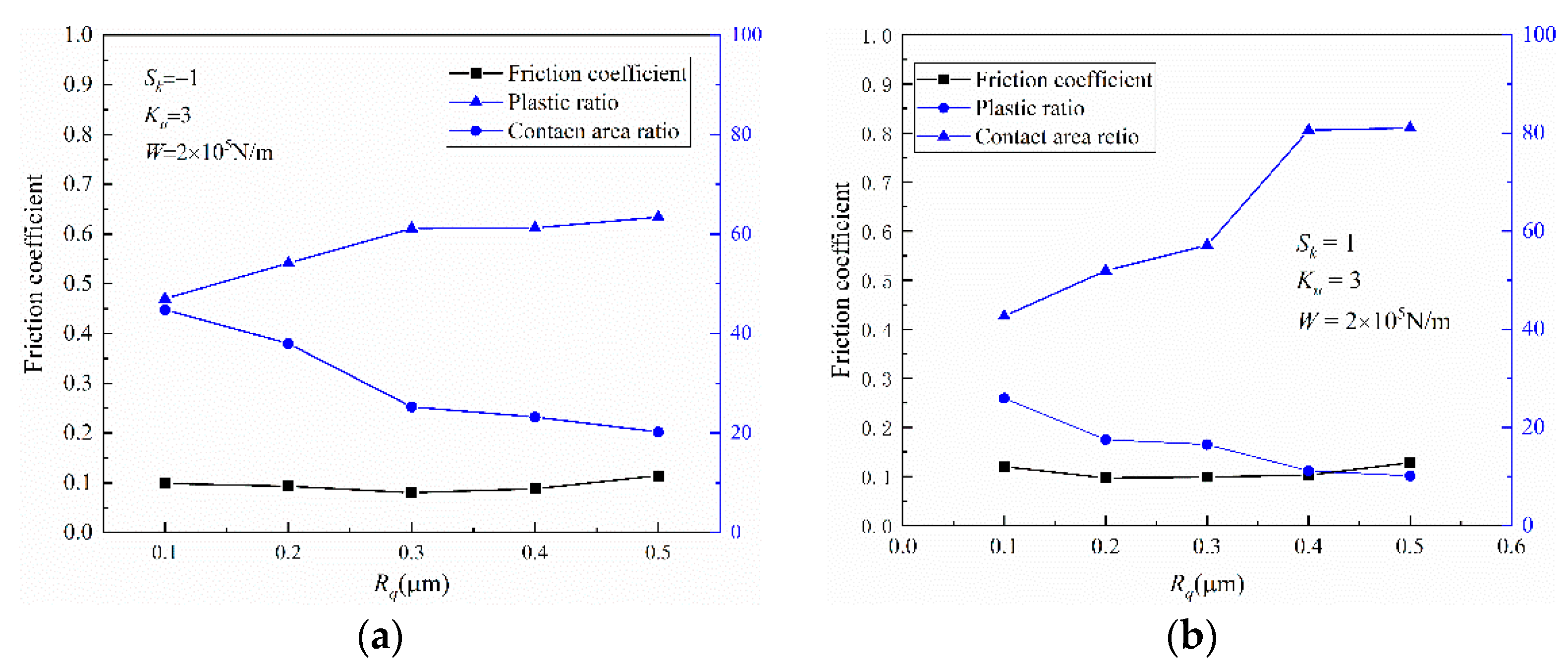
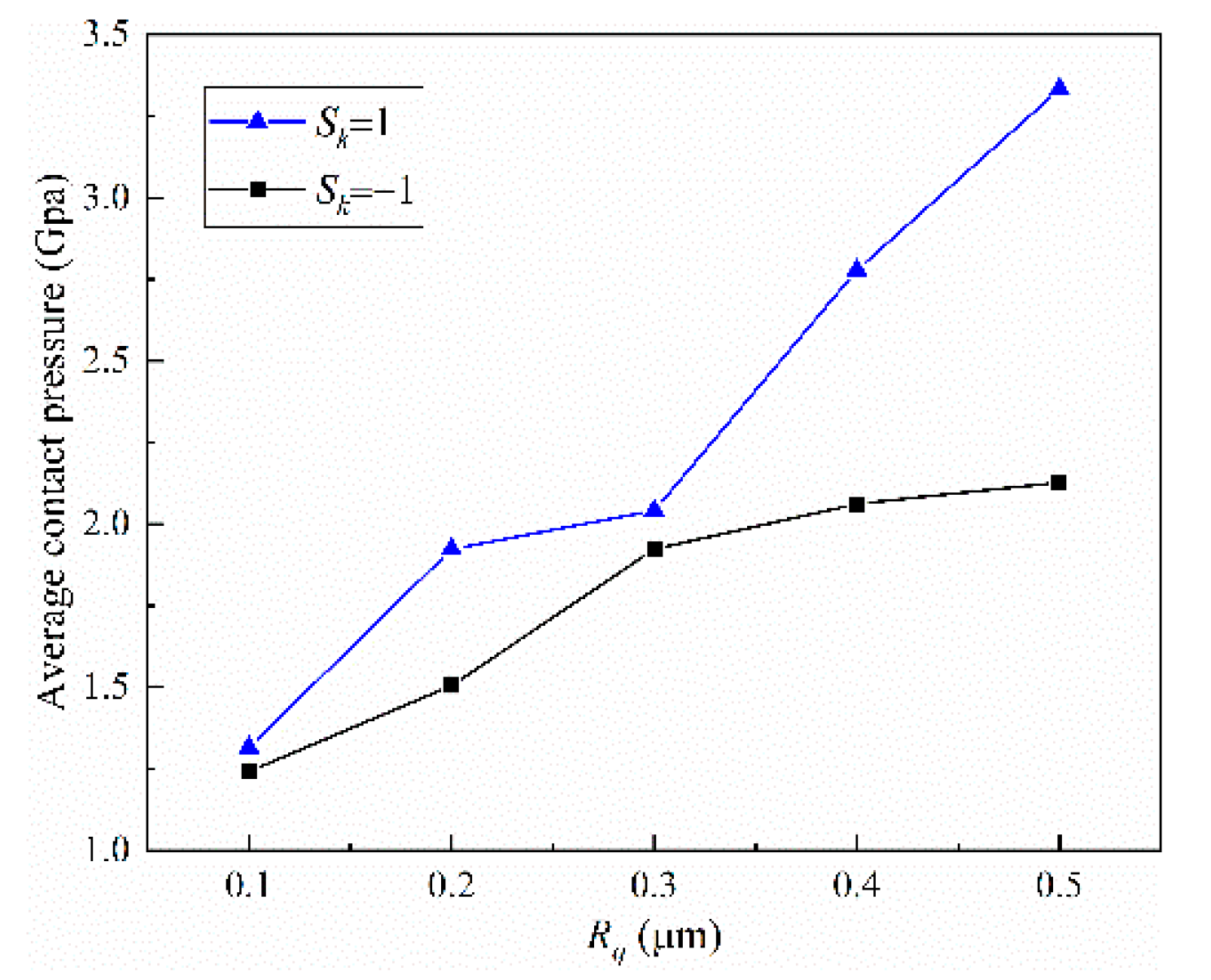
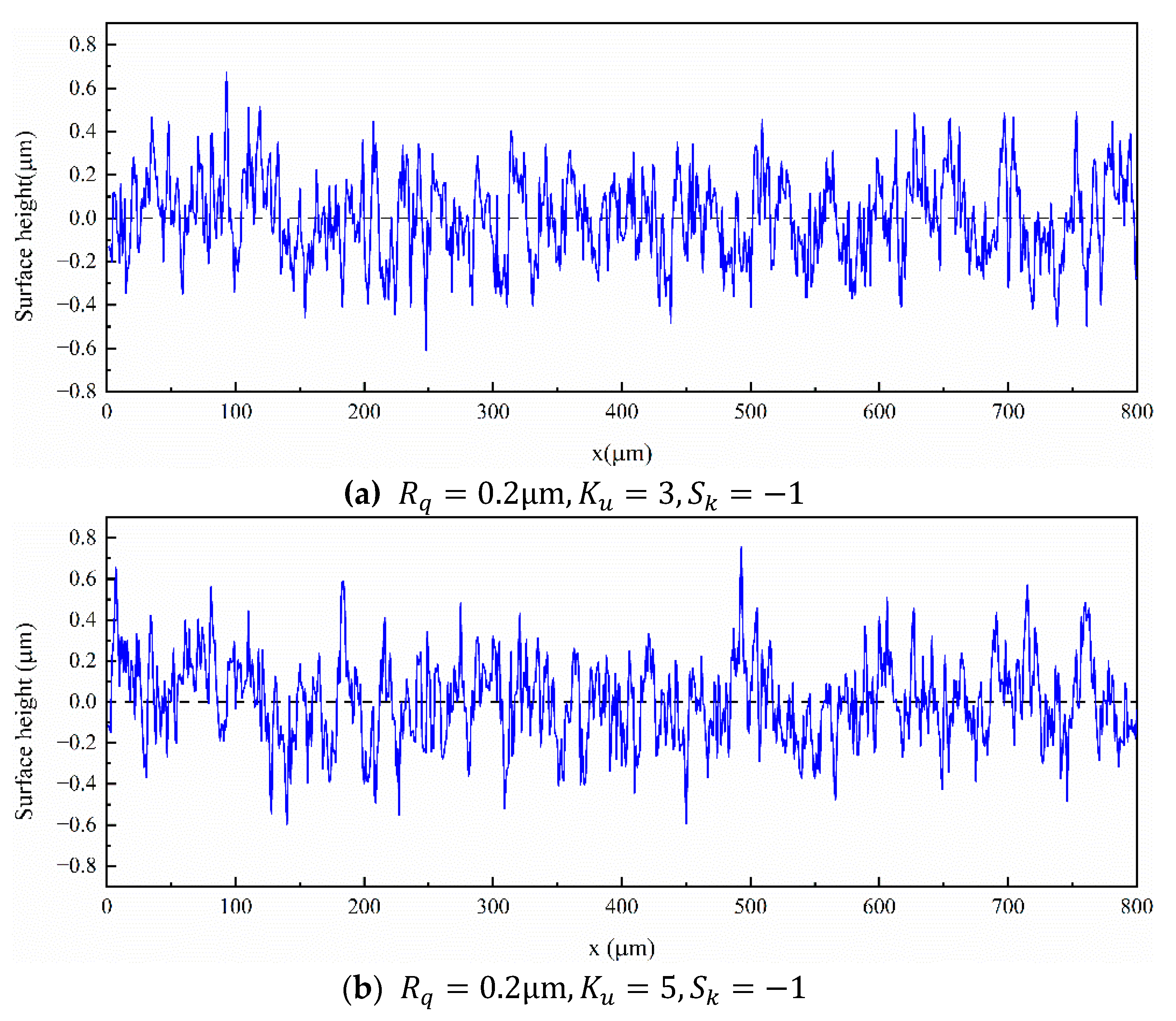
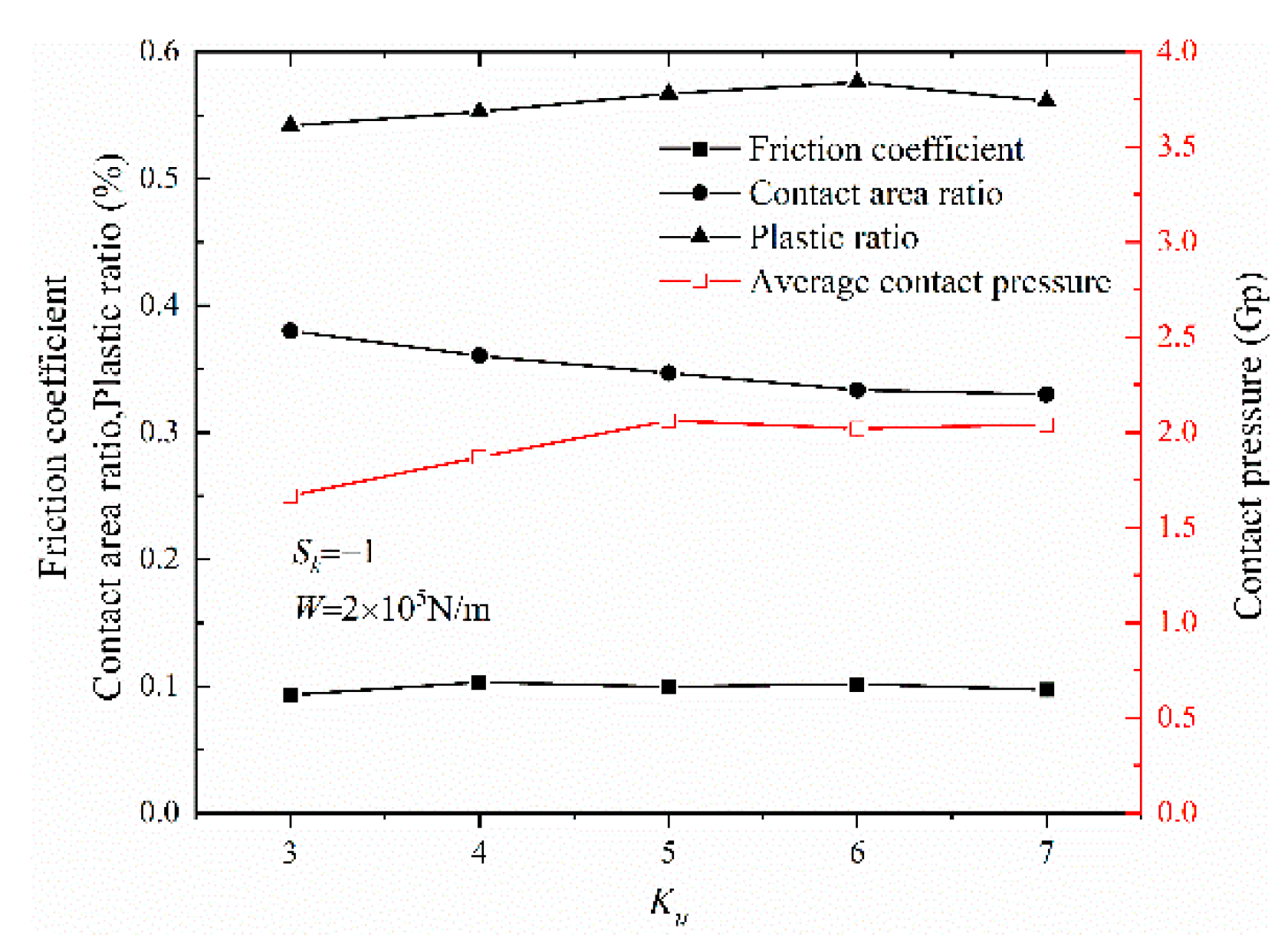
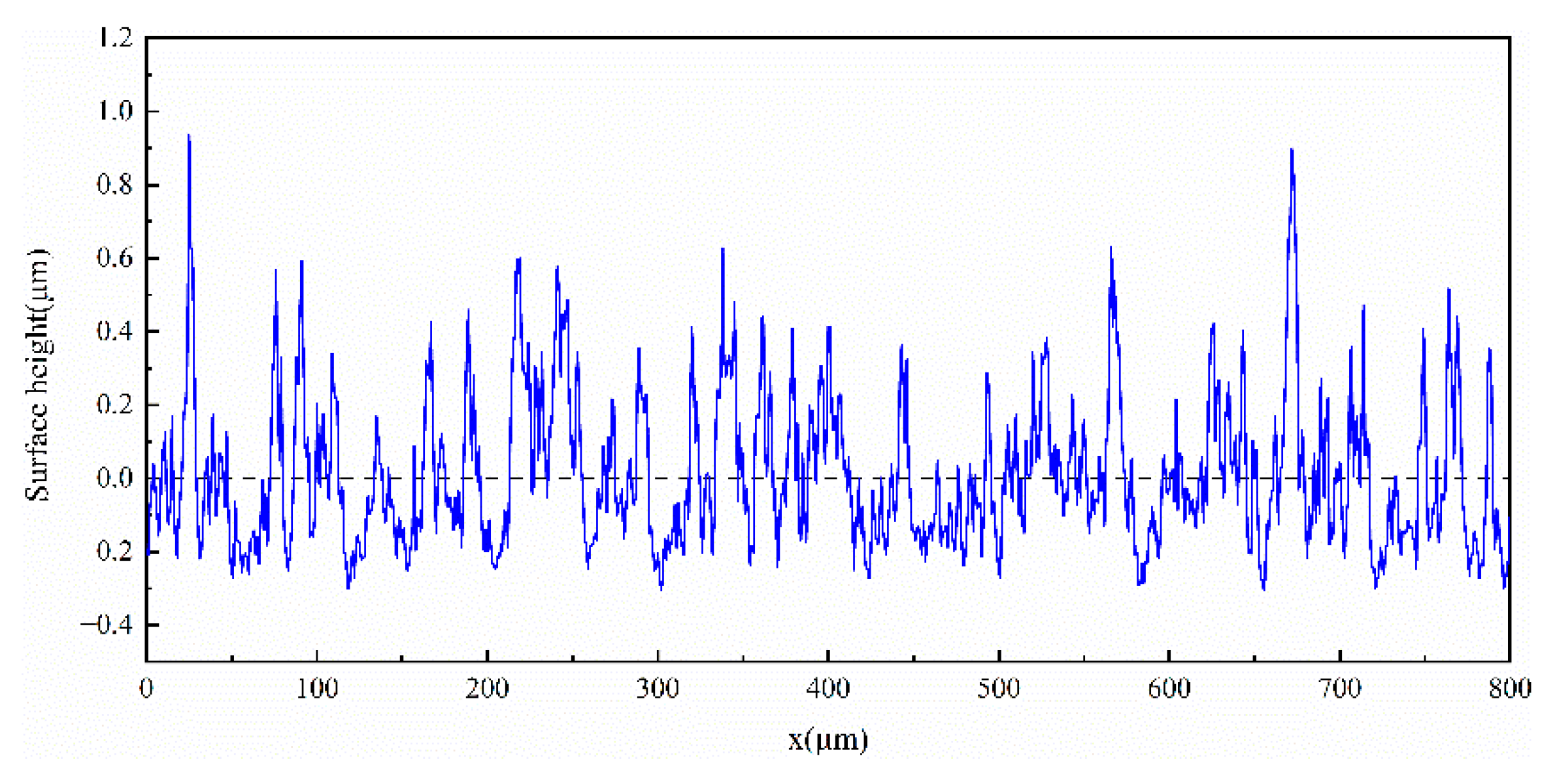

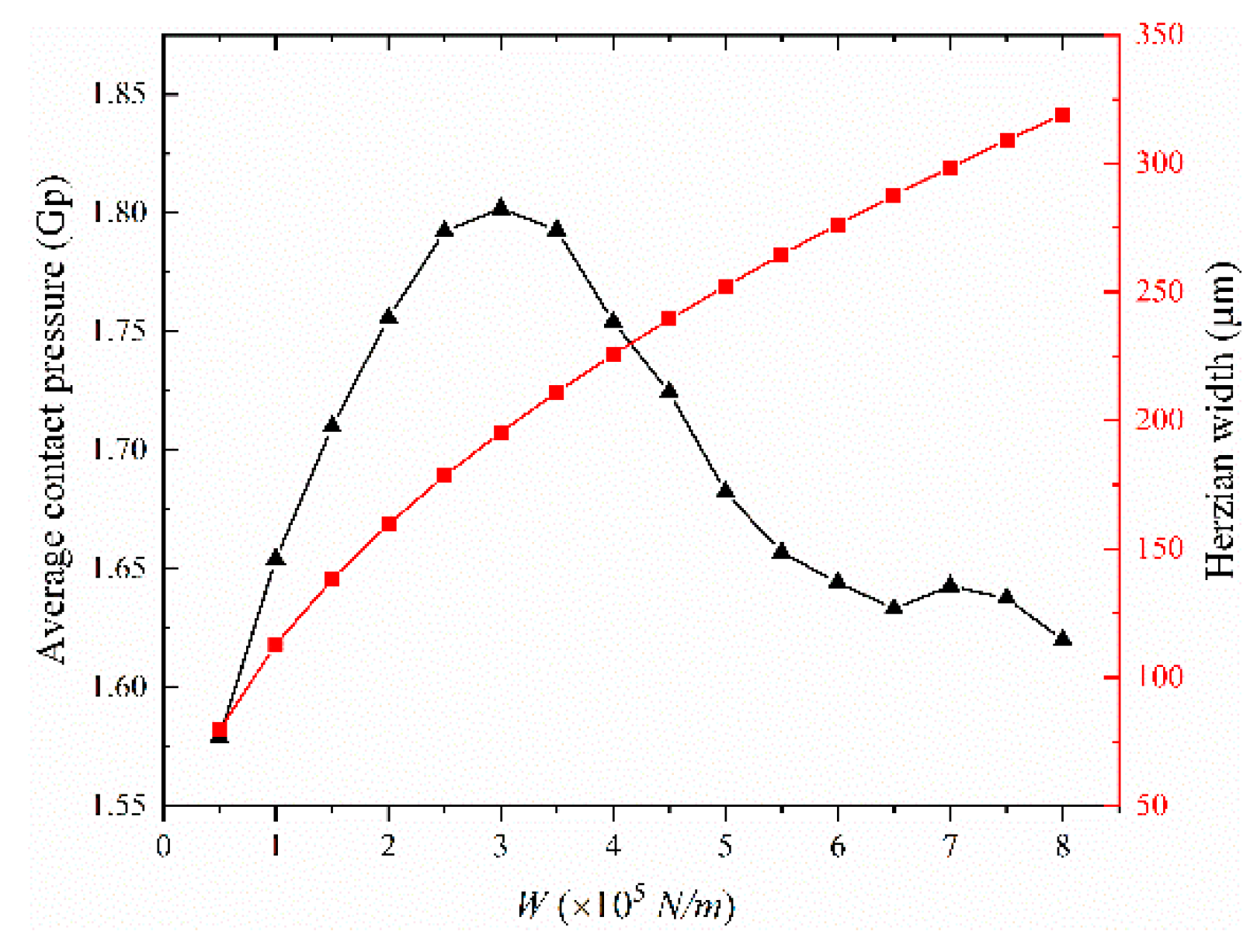
| Applied load W (N/m) | 2 × 105 and 1.5 × 106 |
| Equivalent radius () | 0.0053 |
| Surface roughness | 0.28 and 0.47 |
| Equivalent elastic modulus | 2.28 × 1011 |
| Hardness of rollers H (Gpa) | 4.04 |
| Surfaces | ||||
|---|---|---|---|---|
| 1–5 | 0.1–0.5 | −1 | 3 | |
| 6–10 | 0.1–0.5 | 1 | 3 | |
| 11–15 | 0.3 | −1 | 3–7 | |
| 12 | 0.3 | 0.5–8 | 1 | 4 |
Publisher’s Note: MDPI stays neutral with regard to jurisdictional claims in published maps and institutional affiliations. |
© 2022 by the authors. Licensee MDPI, Basel, Switzerland. This article is an open access article distributed under the terms and conditions of the Creative Commons Attribution (CC BY) license (https://creativecommons.org/licenses/by/4.0/).
Share and Cite
Ren, J.; Yuan, H. Contact Analysis and Friction Prediction of Non-Gaussian Random Surfaces. Appl. Sci. 2022, 12, 11237. https://doi.org/10.3390/app122111237
Ren J, Yuan H. Contact Analysis and Friction Prediction of Non-Gaussian Random Surfaces. Applied Sciences. 2022; 12(21):11237. https://doi.org/10.3390/app122111237
Chicago/Turabian StyleRen, Jinzhao, and Huiqun Yuan. 2022. "Contact Analysis and Friction Prediction of Non-Gaussian Random Surfaces" Applied Sciences 12, no. 21: 11237. https://doi.org/10.3390/app122111237





